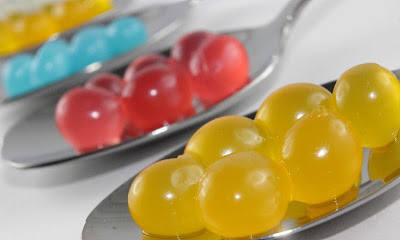The dendê oil, roasted nuts, and coconut milk in xinxim are flavors
that were originally brought to Brazil from Africa. This rich stew is often
prepared for candomblé ceremonies.
This stew is about simple ingredients but with an exotic result. The
favorite Bahian combination of chicken and shrimp comes together in a creamy
sauce. The nuts serve as the perfect binding agents for the coconut milk and
chicken stock but they have to be finely ground – if they are too coarse, they
just won’t do the work. On the other hand, you have to be careful not to turn
the nuts into a paste. The recipe can be prepared up to 2 days ahead of time
and re-heats extremely well. If you prefer to make it ahead of time, it’s best
to hold the shrimp and add them to the pan 5 minutes before serving.
I like to serve this dish by itself, but if you would like a starch to
go with it, white rice or Farofa would be nice.
Preparation time: 10 minutes (plus 30 minutes marinating time)
Cooking time: 35 to 40 minutes
Serves 4 to 6
INGREDIENTS:
juice of 1 large
lemon
2 cloves garlic,
peeled and crushed
2 tsp. salt
1 tsp. pepper
4 to 6 boneless,
skinless chicken breasts
2 tbsp. dende or
peanut oil
1 medium onion,
chopped
1 c. chicken stock or
water
1\2 c. roasted
peanuts, very finely chopped
1\2 c. coconut milk
1 fresh hot pepper or
2 preserved hot peppers, minced (optional)
1 lb. fresh shrimp,
peeled and deveined, or 1 lb. frozen shrimp, thawed
PROCEDURE:
1) In
a large bowl or baking dish, combine lemon juice, garlic, salt, and pepper to
make marinade.
2) Wash
chicken under cool running water. Pat dry and cut into 1-inch chunks. Place
chicken in marinade, cover dish with plastic wrap, and refrigerate for 30
minutes.
3) In
a heavy saucepan or skillet, heat oil over medium-high heat. Add onion and
chicken pieces and cook 10 minutes, or until chicken is lightly browned.
4) Add
chicken stock or water, peanuts, coconut milk, and hot pepper (if using). Reduce heat to medium.
Simmer, stirring occasionally, for 15 to 20 minutes, or until chicken is fully
cooked and sauce has thickened.
5) Add shrimp and cook 8 to 10 minutes
more, or until shrimp are pink. If you have dende oil, drizzle lightly over all
before serving.
Quick Tips:
You
may be able to have fresh shrimp peeled and deveined at the grocery store.
Otherwise, hold the shrimp with the underside facing you. Use your fingers to
peel off the shell from the head toward the tail. Carefully use a sharp knife
to make a shallow cut down the middle of the back. Hold the shrimp under cold
running water to rinse out the dark vein.
Chicken Pieces. When cutting the chicken, aim for 2
wings, 2 breasts, 2 drumsticks and 2 thighs. If that takes up a lot of space in
the pan and will require for you to use 2 skillets, you can also cut the
chicken in 6 pieces, leaving the thigh and drum attached and cutting them apart
only when they go to the braising stage. It is also possible to buy the chicken
pre-cut from the market.
Dendê oil or Palm
oil is an edible vegetable
oil derived from the mesocarp (reddish pulp) of the fruit of the oil palms,
primarily the African oil palm Elaeis guineensis, and to a lesser extent
from the American oil palm Elaeis oleifera and the maripa palm Attalea
maripa.
Palm oil is naturally
reddish in color because of a high beta-carotene
content. It is not to be confused with palm kernel oil derived from the
kernel of the same fruit, or coconut oil derived from the kernel of the coconut
palm (Cocos nucifera). The differences
are in color (raw palm kernel oil lacks carotenoids and is not red), and in
saturated fat content: Palm mesocarp oil is 41% saturated, while Palm Kernel
oil and Coconut oil are 81% and 86% saturated respectively.
Watch Video: Ximxim de
Galinha
CALORIE COUNTER:
1)
Chicken, Meat Only
chicken,
chicken breast, meat
B- Grade
266 Calories
Nutrition Facts
Serving Size 1 cup, chopped or diced (140 g)
Per Serving
|
%
Daily Value
|
Calories 266
|
|
Calories from Fat 93
|
|
Total Fat 10.4g
|
16%
|
Saturated Fat 2.9g
|
14%
|
Polyunsaturated Fat 2.4g
|
|
Monounsaturated Fat 3.7g
|
|
Cholesterol 125mg
|
42%
|
Sodium 120mg
|
5%
|
Potassium 340mg
|
10%
|
Carbohydrates 0.0g
|
0%
|
Dietary Fiber 0.0g
|
0%
|
Sugars 0.0g
|
|
Protein 40.5g
|
|
Vitamin A
|
1% ·
|
Vitamin C
|
0%
|
Calcium
|
2%
|
Iron
|
9%
|
2)
Shrimps
shrimp,
seafood
B-- Grade
33 Calories
Nutrition Facts
Serving Size 1 oz (28
g)
Per Serving
|
%
Daily Value
|
Calories 33
|
|
Calories from Fat 5
|
|
Total Fat 0.6g
|
1%
|
Carbohydrates 0.0g
|
0%
|
Dietary Fiber 0.0g
|
0%
|
Protein 6.4g
|
|
3)
Peanuts, All Types, Dry-roasted
Without Salt
peanuts
B+ Grade
166 Calories
Nutrition Facts
Serving Size 1 oz (28
g)
Per Serving
|
%
Daily Value
|
Calories 166
|
|
Calories from Fat 126
|
|
Total Fat 14.1g
|
22%
|
Saturated Fat 2.0g
|
10%
|
Polyunsaturated Fat 4.4g
|
|
Monounsaturated Fat 7.0g
|
|
Cholesterol 0mg
|
0%
|
Sodium 2mg
|
0%
|
Potassium 186mg
|
5%
|
Carbohydrates 6.1g
|
2%
|
Dietary Fiber 2.3g
|
9%
|
Sugars 1.2g
|
|
Protein 6.7g
|
|
Vitamin A
|
0%
|
Vitamin C
|
0%
|
Calcium
|
2%
|
Iron
|
4%
|


No comments:
Post a Comment